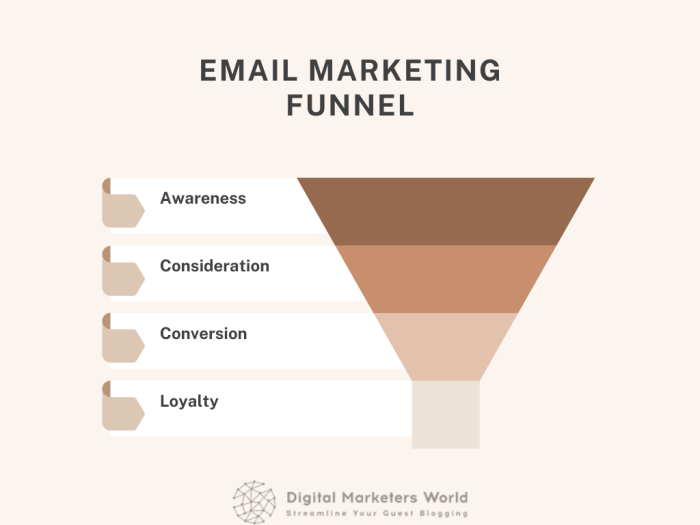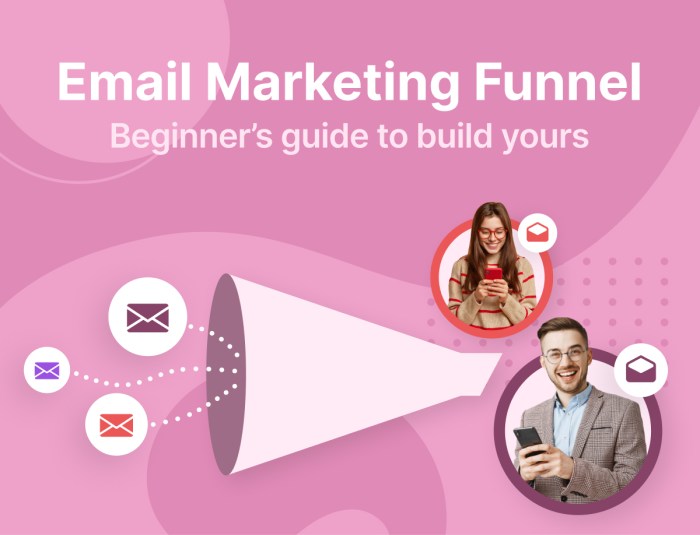Building an Email Marketing Funnel kicks off the journey into the digital marketing realm, where crafting engaging content, converting leads, and connecting with your audience are key players in the game. Get ready to level up your email marketing strategy with these expert tips and tricks.
Introduction to Email Marketing Funnel
An email marketing funnel is a strategic process that businesses use to guide potential customers through a series of stages with the ultimate goal of converting them into paying customers. It involves sending targeted emails to prospects at different points in their buying journey to nurture them and build a relationship.
Building an effective email marketing funnel is crucial for businesses as it helps in engaging with leads, increasing brand awareness, driving sales, and ultimately growing revenue. By segmenting the audience and sending personalized content, businesses can tailor their messages to the specific needs and interests of each prospect, increasing the chances of conversion.
Stages of an Email Marketing Funnel
- 1. Awareness: In this stage, businesses introduce themselves to potential customers and create brand awareness through educational content, blog posts, or free resources.
- 2. Interest: Once prospects are aware of the brand, businesses aim to capture their interest by providing valuable content, such as case studies, testimonials, or product demos.
- 3. Decision: In this stage, prospects are considering making a purchase. Businesses send targeted emails with special offers, discounts, or product information to encourage conversion.
- 4. Action: The final stage involves converting leads into customers. Businesses send emails with clear calls-to-action, such as “Buy Now” buttons or sign-up forms, to prompt the desired action.
Examples of Successful Email Marketing Funnels
One successful example of an email marketing funnel is from Amazon. The e-commerce giant sends personalized product recommendations based on the customer’s browsing and purchase history, leading to increased sales and customer loyalty. Another example is from Airbnb, which sends targeted emails with travel tips, destination guides, and accommodation suggestions to inspire bookings and enhance the user experience.
Creating a Lead Magnet

Lead magnets are essential tools in email marketing funnels as they are incentives offered to potential subscribers in exchange for their email addresses. These magnets attract subscribers by providing value or solving a specific problem for them.
Examples of Effective Lead Magnets
- An exclusive ebook offering valuable insights and tips related to the business niche.
- A free webinar providing in-depth knowledge on a trending topic in the industry.
- Downloadable templates that simplify a complex process for the audience.
Types of Lead Magnets
- Ebooks: Detailed guides or reports that offer valuable information to the audience.
- Webinars: Live or recorded online seminars that educate the audience on a specific topic.
- Templates: Ready-to-use tools that help the audience solve a particular issue or simplify a task.
Tips for Creating Compelling Lead Magnets
- Understand Your Audience: Tailor the lead magnet to address the specific needs and interests of your target audience.
- Provide Value: Ensure that the lead magnet offers valuable information or solutions that resonate with the audience.
- Clear Call-to-Action: Clearly communicate the benefits of the lead magnet and prompt the audience to subscribe to access it.
- Engaging Design: Use visually appealing designs and formats to make the lead magnet attractive and easy to consume.
Designing Opt-in Forms

Opt-in forms play a crucial role in capturing email leads for your marketing funnel. These forms allow visitors to your website to willingly provide their contact information, showing interest in your products or services.
Significance of Opt-in Forms
- Opt-in forms help build your email list with engaged and interested subscribers.
- They serve as a direct communication channel to nurture leads and convert them into customers.
- By obtaining permission to send emails, opt-in forms ensure compliance with anti-spam regulations.
Best Practices for Designing Opt-in Forms, Building an Email Marketing Funnel
- Keep the form simple and easy to fill out, asking for minimal information like name and email address.
- Include a compelling call-to-action that clearly explains the benefit of signing up.
- Use eye-catching colors and design elements that grab attention without overwhelming the page.
- Consider using pop-up forms, slide-ins, or sticky bars to increase visibility.
Placement and Timing of Opt-in Forms
- Place opt-in forms strategically on high-traffic pages like the homepage, blog posts, and landing pages.
- Experiment with different placements to find what works best for your audience, such as inline forms, top bars, or exit-intent pop-ups.
- Consider the timing of your opt-in forms to avoid interrupting the user experience, such as triggering after a certain amount of time or scrolling.
Examples of Creative Opt-in Form Designs
- A minimalist opt-in form with a single-field input and a bold submit button.
- An interactive quiz opt-in form that engages visitors and provides personalized recommendations.
- A countdown timer opt-in form offering a limited-time discount or promotion to encourage immediate sign-ups.
Segmentation and Personalization: Building An Email Marketing Funnel
Segmentation and personalization are key components of a successful email marketing strategy. By dividing your email list into segments based on specific criteria, you can tailor your campaigns to target the right audience with the right message. Personalization, on the other hand, involves customizing emails to make them more relevant and engaging for individual recipients.
Importance of Segmentation
Segmenting your email list allows you to send targeted campaigns to specific groups of subscribers. This can lead to higher open rates, click-through rates, and ultimately, conversions. By sending relevant content to the right people, you can increase engagement and build stronger relationships with your audience.
- Segment based on demographics such as age, gender, location, or job title
- Segment by behavior, such as past purchases, website interactions, or email engagement
- Use segmentation to send personalized content and offers to different groups
Benefits of Personalization
Personalizing emails can significantly impact your open rates and engagement levels. By addressing recipients by name, recommending products based on their past purchases, or sending targeted content based on their interests, you can create a more personalized experience that resonates with your subscribers.
- Personalized subject lines can increase open rates
- Dynamic content based on user behavior can improve click-through rates
- Using personalization tokens for first name or location can make emails feel more individualized
Examples of Successful Personalized Campaigns
One successful example of personalized email marketing is Amazon’s product recommendations based on past purchases and browsing history. By suggesting products that align with a customer’s interests, Amazon boosts engagement and drives sales. Another example is Spotify’s personalized playlists, which are curated based on a user’s listening habits and preferences, enhancing the overall user experience.
